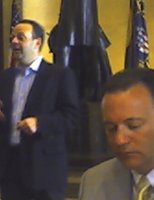 Mike Lieberman, co-founder of Square 2 Marketing, presented some excellent advice to members of the Philadelphia Drexel alumni Club at the Union League today.
Mike Lieberman, co-founder of Square 2 Marketing, presented some excellent advice to members of the Philadelphia Drexel alumni Club at the Union League today.His remarks were directed towards business people involved in marketing functions.
The title of his presentation was: My Marketing Isn't Working, and I Don't Know Why.
Here is a summary of his key points:
- Make your product or service remarkable (Seth Godin's book Purple Cow was recommended.)
- Narrow your focus so that when your prospect reads your pitch, she/he can relate to it.
- Use language that targets the pains and problems of your prospect.
- Provide unique solutions to those problems.
- Design a series of messages to send to your prospects, because a single marketing effort is worthless.
- Create a no-risk offer as a way to get a prospect involved.
- Be sure to capture contact information so that you can continue to communicate with each prospect.
Mike also shared with us his method for creating a monthly calendar of marketing activities to stay on track.
Many participants stayed around afterwards to talk about the presentation with each other and with Mike Lieberman.
I found Mike to be a personable and knowledgeable marketing professional. It was great to meet at the Drexel Alumni luncheon.
For more information about Square 2 Marketing, visit their web site at: www.square2marketing.com to find out more about marketing that works.
Bill Ringle is a business growth strategist and eBusiness Expert. Visit www.billringle.com for more info on Bill's companies and projects.




